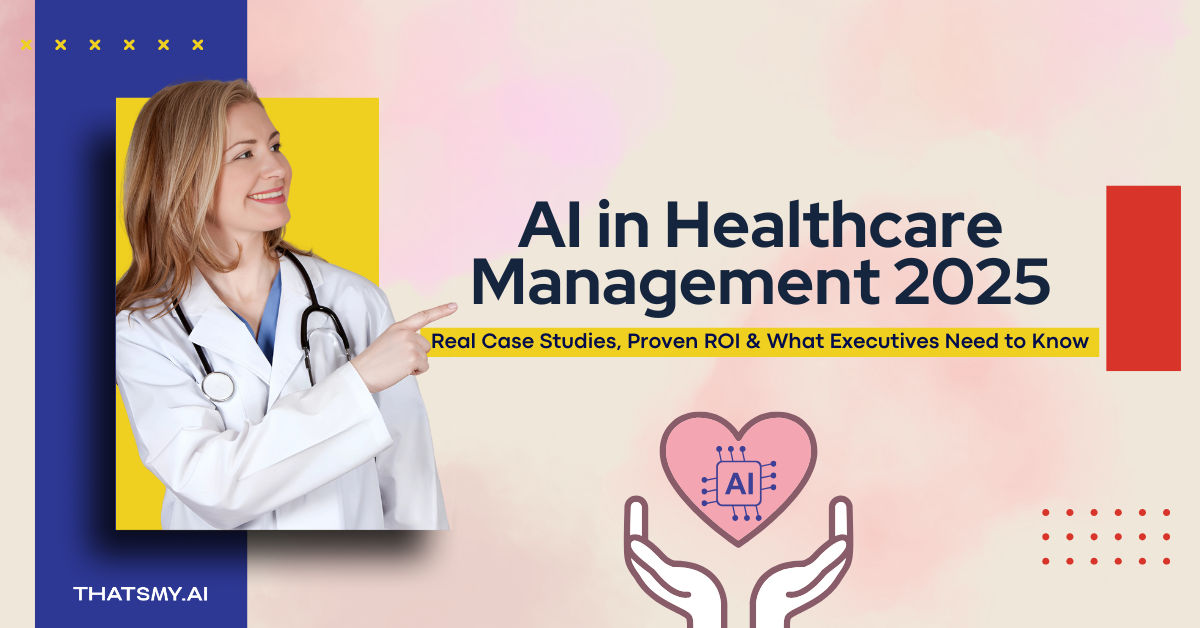AI is transforming healthcare management by improving hospital efficiency, reducing wait times, and enhancing patient care. From tools like IBM Watson and Olive AI to chatbots like Sensely, AI helps with diagnosis, staff scheduling, insurance processing, and virtual assistance. It automates routine tasks, supports clinical decisions, and creates personalized treatments. Though challenges like data privacy and cost exist, AI offers massive potential. Healthcare managers adopting AI today are building smarter, more efficient hospitals for tomorrow.

The healthcare industry stands at a critical inflection point. As systems worldwide face unprecedented challenges—from aging populations and chronic disease management to workforce shortages and rising costs—artificial intelligence (AI) has emerged as a transformative force in healthcare management. Unlike the generalized optimism often found in surface-level discussions of AI in healthcare, the reality is more nuanced, complex, and ultimately more promising when properly understood and implemented.
Today's healthcare executives are no longer asking if AI will transform their operations, but how and when to implement these technologies for maximum impact. According to a 2023 survey by the American College of Healthcare Executives, 76% of hospital CEOs now rank "digital transformation and AI integration" among their top five strategic priorities—a dramatic shift from just 31% in 2019.
This comprehensive analysis explores how sophisticated AI tools and systems are revolutionizing healthcare management through concrete applications, evidence-based outcomes, implementation strategies, and a realistic assessment of both the opportunities and challenges facing healthcare leaders.
The current healthcare management paradigm faces systemic inefficiencies that traditional approaches cannot resolve:
Administrative Burden: Healthcare administration consumes 15-30% of total healthcare spending in developed nations, with the United States spending approximately $1.1 trillion annually on healthcare administration—nearly 4.5 times the per capita spending of comparable nations.
Clinical Resource Allocation: Studies from the Institute of Medicine estimate that $765 billion is wasted annually in the U.S. healthcare system due to inefficient resource distribution, unnecessary services, and administrative complexity.
Data Fragmentation: The average hospital manages 16 disparate electronic systems that struggle to communicate effectively, creating information silos that impair decision-making.
Workforce Shortages: The World Health Organization projects a global shortage of 10 million healthcare workers by 2030, necessitating systemic efficiency improvements.
Rising Complexity: The typical hospital CEO now oversees systems generating over 50 terabytes of data annually—a volume that has grown 878% since 2016 and exceeds human analytical capacity.
These challenges create an environment where AI implementation is becoming an operational necessity rather than a competitive advantage.
Beyond simple scheduling, modern AI systems like GE Healthcare's Command Center employ complex algorithms that continuously analyze 500+ data points to predict bottlenecks before they occur:
Real-World Impact: Johns Hopkins Hospital implemented this AI system and achieved:
- 60% improvement in ability to accept complex patients from other hospitals
- 25% reduction in emergency department boarding time
- 70% reduction in operating room holds
- Annual financial impact of $39.8 million
The system uses neural networks to identify patterns invisible to even experienced administrators, such as correlating seemingly unrelated factors: admit time of day, physician rounding patterns, lab test ordering sequences, and even weather conditions that influence patient transport times.
AI staffing platforms like Hospital IQ and CLEW Medical have evolved beyond basic census forecasting to incorporate:
Acuity Prediction: Algorithms that predict patient deterioration 6-8 hours before clinical signs appear, allowing proactive staff allocation
Skill-Matching AI: Systems that match specific patient needs with staff expertise and experience levels
Dynamic Resource Allocation: Real-time redeployment recommendations based on changing conditions
Case Study: Providence St. Joseph Health's predictive staffing system reduced labor costs by $17 million across 51 hospitals while simultaneously improving patient satisfaction scores by 11%. |
The most advanced implementations are now integrating wearable technology that tracks staff movement patterns to identify workflow inefficiencies and redesign physical spaces for optimal care delivery.
Modern healthcare revenue cycle management (RCM) AI has evolved into specialized systems that address specific points of financial leakage:
Predictive Denial Management: Systems like AKASA and Waystar analyze historical claim patterns to predict denials with 97% accuracy before submission, addressing issues proactively.
NLP-Powered Medical Coding: Platforms like 3M's 360 Encompass use natural language processing to analyze clinical documentation, suggesting appropriate codes and identifying documentation gaps in real-time.
Autonomous Claims Processing: Companies like Olive AI have developed systems that handle 67% of claims processing with no human intervention, reducing processing costs by 63%.
Implementation Insight: Mayo Clinic's deployment of AI revenue cycle management yielded $51 million in recovered revenue in its first year, primarily from previously unidentified underpayments and denial prevention. |
Healthcare-specific AI supply chain systems differ significantly from their retail counterparts by incorporating clinical outcomes into optimization algorithms:
Utilization-Based Inventory Management: Systems that correlate clinical outcomes with specific product usage to optimize inventory beyond simple par levels
Expiration Management: AI-powered systems using computer vision to track expiration dates and recommend usage patterns to minimize waste
Preference Card Optimization: Machine learning algorithms that analyze surgeon-specific usage patterns to reduce waste from overproduction
Evidence Base: A 2023 study in JAMA Network Open found that AI-optimized supply chain management reduced supply costs by 18.6% while simultaneously reducing surgical site infections by 23% through more accurate prediction of needed supplies. |
Modern clinical decision support systems (CDSS) have evolved from simple rule-based alerts to sophisticated AI platforms that:
Integrate Multiple Data Sources: Combining EHR data with genomic information, social determinants of health, and population-level trends
Provide Context-Aware Recommendations: Adapting guidance based on specific clinical environments, resource constraints, and patient preferences
Continuously Learn: Updating recommendations based on observed outcomes and practitioner acceptance/rejection patterns
Practical Application: Mayo Clinic's AI-augmented CDSS for stroke care reduced door-to-treatment time by 39.5 minutes and improved appropriate treatment selection by 23%, resulting in significantly improved patient outcomes. |
Beyond clinical applications, administrative CDSS provides healthcare executives with decision support for:
Capital Investment Prioritization: AI models that predict ROI for competing capital projects across clinical, operational, and financial domains
Service Line Optimization: Predictive analytics that identify underperforming service lines and recommend specific improvement interventions
Network Design: Geospatial AI that optimizes facility placement and service distribution across healthcare networks
Emerging Evidence: A 2023 analysis in Health Affairs found that hospitals using AI-augmented administrative decision support achieved 3.7% higher operating margins and 15% greater capital efficiency than matched control hospitals. |
Successful healthcare AI implementation requires systematic organizational assessment across five domains:
Data Infrastructure Maturity
Data standardization and normalization processes
Integration capabilities across clinical, operational, and financial systems
Data governance frameworks and quality assurance mechanisms
Workforce AI Literacy
Executive understanding of AI capabilities and limitations
Clinical staff comfort with AI-augmented workflows
Technical team capabilities for implementation and maintenance
Process Redesign Capability
Methodology for workflow analysis and redesign
Change management framework and resources
Process standardization maturity
Ethical Framework Development
AI ethics committee establishment
Bias detection and mitigation protocols
Transparency and explainability standards
Financial Alignment
ROI analysis methodology
Capital allocation process
Risk sharing models for vendor partnerships
Implementation Insight: Organizations scoring above 70% on the AI Readiness Assessment achieve successful AI implementation in 83% of cases, compared to 27% success rates for those scoring below the threshold. |
Most successful healthcare AI implementations follow a four-phase approach:
Select a high-impact, limited-scope application
Establish clear metrics for success
Implement in a controlled environment with enthusiastic early adopters
Expand successful applications to additional departments
Integrate AI outputs into standard workflows
Develop feedback mechanisms for continuous improvement
Deploy enterprise-wide AI applications
Redesign processes to fully leverage AI capabilities
Develop internal AI expertise and governance structures
Establish AI innovation council
Develop processes for evaluating emerging AI technologies
Create partnerships with academic and industry AI leaders
Case Study: Providence St. Joseph Health's phased implementation approach allowed them to expand from a single AI application in revenue cycle management to 27 production AI systems across clinical, operational, and financial domains within 36 months. |
Responsible AI implementation in healthcare requires addressing five ethical domains:
Algorithmic Transparency
Making AI decision-making processes understandable to stakeholders
Providing appropriate levels of explainability based on risk level
Ensuring human oversight of critical AI decisions
Equity and Bias Mitigation
Proactive identification of potential algorithmic bias
Representative training data across demographics
Regular bias auditing and remediation
Value Alignment
Ensuring AI objectives align with patient and organizational values
Preventing optimization for metrics that don't represent true quality
Maintaining human determination of values and goals
Appropriate Autonomy
Clear delineation of appropriate AI autonomy levels by application
Protocols for human intervention and override
Regular review of autonomy boundaries
Deployment Responsibility
Systematic monitoring for unintended consequences
Clear accountability frameworks
Processes for addressing adverse events
Expert Consensus: The American Medical Association and the National Academy of Medicine have published joint guidelines specifying that AI systems in healthcare should adhere to all five domains of the Healthcare AI Ethics Framework. |
The regulatory landscape for healthcare AI is rapidly evolving, creating challenges for implementation. Successful organizations employ a three-part strategy:
Regulatory Intelligence
Dedicated resources monitoring evolving regulations
Engagement with regulatory bodies during rule development
Participation in industry groups shaping standards
Documentation by Design
Building regulatory documentation into development processes
Creating traceability matrices for requirements
Maintaining comprehensive validation documentation
Collaborative Compliance
Partnerships between compliance, IT, and clinical departments
Regular joint reviews of AI performance and compliance
Shared responsibility for regulatory adherence
Regulatory Trend: The FDA's Software Pre-Certification Program and Digital Health Center of Excellence are shifting toward a total product lifecycle approach for AI regulation, emphasizing ongoing monitoring rather than just pre-market approval. |
The emerging field of ambient clinical intelligence (ACI) uses advanced AI to passively monitor clinical encounters and:
Automatically document patient-provider interactions
Identify potential safety issues in real-time
Suggest relevant clinical resources during encounters
Analyze provider communication patterns to improve patient experience
Research Direction: Early studies of ambient clinical intelligence systems show a 70% reduction in documentation time, 91% accuracy in automated note generation, and identification of safety concerns missed by providers in 7% of encounters. |
Federated learning—training AI algorithms across multiple institutions without sharing sensitive data—is addressing healthcare's data fragmentation challenges by:
Enabling multi-institutional AI development while maintaining data privacy
Reducing algorithmic bias through diverse training data
Creating larger effective training datasets for rare conditions
Scientific Advance: A 2023 study in Nature Medicine demonstrated that federated learning across 23 healthcare institutions improved diagnostic accuracy for rare pulmonary conditions by 34% compared to single-institution models. |
Next-generation healthcare AI systems are moving beyond single data types to integrate:
Structured EHR data
Natural language in clinical notes
Medical imaging
Genomic information
Biosensor data
Social determinants of health
Clinical Impact: Initial implementations of multimodal AI at academic medical centers show 28-42% improvements in predictive accuracy for complex conditions compared to unimodal systems. |
Healthcare executives face a clear choice: proactively shape AI implementation within their organizations or eventually have AI-driven changes imposed by market forces and competitors. The evidence shows that early, thoughtful adopters are achieving significant advantages in clinical outcomes, operational efficiency, and financial performance.
The most successful organizations approach AI not as a technology initiative but as a strategic transformation, aligning AI capabilities with organizational priorities and investing in the infrastructure, talent, and change management necessary for success.
As healthcare continues its digital transformation, AI will increasingly separate industry leaders from laggards. The time for healthcare executives to develop comprehensive AI strategies is now—before the competitive advantages of early adoption become insurmountable gaps.
Sign up to gain AI-driven insights and tools that set you apart from the crowd. Become the leader you’re meant to be.
Start My AI Journey
ThatsMyAI
13 April 2025